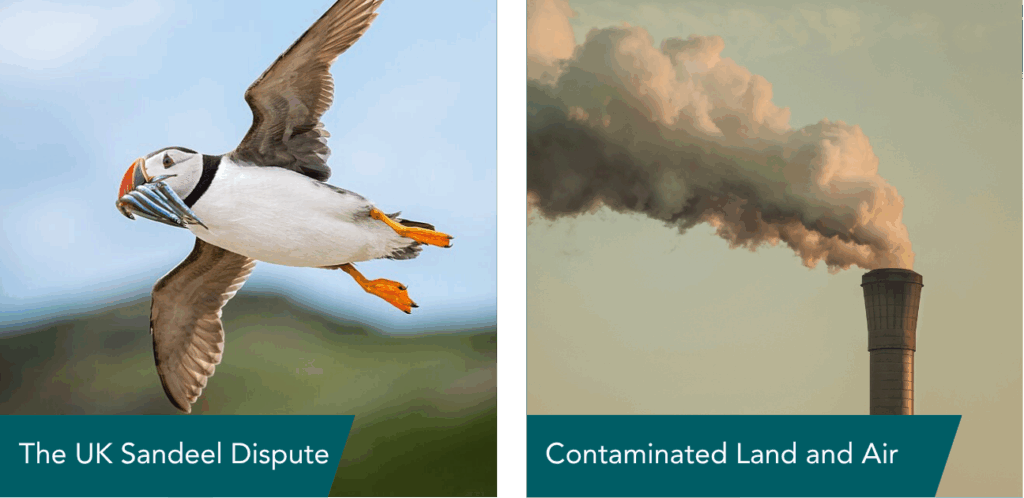The UK-Sandeel Dispute, Contaminated Land Cases, Late Submissions, and Climate Change Obligations
July 25, 2025

This latest Environmental Law Update explores two significant environmental law cases that highlight the evolving regulatory landscape. Victoria Kaye discusses the UK-Sandeel case, the first major dispute under the new EU-UK Trade and Cooperation Agreement, focusing on the tension between environmental protection and trade rights. Meanwhile, William Upton KC examines the legal complexities surrounding contaminated land, specifically in the case of the fires at Launders Lane, where issues of air quality and risk assessment are brought to the forefront, as well as the Court of Appeal’s recent decision on late submissions in public inquiries, highlighting how new evidence can impact legal challenges post-inquiry. Finally, Gordon Wignall explores the International Court of Justice’s Advisory Opinion on state obligations related to climate change, offering key insights into the evolving responsibilities of nations in mitigating global warming.
EU/UK Trade and the environment – arguing over restrictions:
The European Union v The United Kingdom: PCA Case No.2024-45, UK-SANDEEL.
In the choppy waters of post-Brexit relations, a small eel-like fish has found itself at the centre of the first major legal dispute between the EU and UK under their new Trade and Cooperation Agreement (“TCA”). It is the first indication of how the environmental protection and trade obligations in the TCA will coexist. It is not yet completely resolved, as the UK confirmed its closure of its sandeel fisheries on 25 June despite a ruling by the Permanent Court of Arbitration in The Hague this April that it had failed to act proportionally in its initial decision. In a phrase that those who deal with public authorities will recognise when they don’t want to change direction, the UK has described its initial failure as “a procedural shortcoming in the process”.
The case is not just about fish – although its importance for that sector will continue as the EU and the UK have agreed to extend mutual access to each other’s waters for a further 12 years (on 19 May). The Arbitration marked the first time the dispute resolution mechanism in the post-Brexit Trade and Cooperation Agreement was put to the test.
Sandeels are small fish that punch far above their weight in marine ecosystems: they are vital sustenance for certain marine mammals, predatory fish and seabirds. In response to dwindling stocks, thought to be at the heart of the ecological crisis unfolding across the North Sea, the UK and Scottish governments banned all sandeel fishing in their North Sea waters. The objective was to boost sandeel populations to support struggling seabird colonies and to strengthen marine ecosystems. But here is where it gets complicated. UK boats had not been allocated sandeel quotas since 2021, so that the ban devastated EU fishing operations (and in particular Danish fleets, which hold over 96% of the EU sandeel fishing quota in UK waters). What the UK framed as environmental stewardship, the EU saw as a unilateral trade barrier dressed up as conservation.
The Legal Framework
The EU initiated arbitration proceedings in October 2024 after consultations failed to reach a mutually agreed solution. They argued that the fishing prohibition violated the TCA because it was not based on “best available scientific advice”, that the prohibition failed to be proportionate and non-discriminatory, and that the prohibition improperly restricted EU vessels’ guaranteed access to UK fishing waters. The UK pushed back, emphasising its regulatory autonomy under the agreement. As it submitted, this was fundamentally about ‘fishing in somebody else’s waters’ and the UK’s right to pursue a high level of protection of the ecosystem in the North Sea.
The Tribunal delivered a nuanced ruling that handed both sides partial victories. The UK secured significant wins in that the Tribunal dismissed the claim that the fishing ban was not based on the best available scientific advice. It also found that the ban in Scottish waters was proportionate and not discriminatory. But it found for the EU in that the prohibition in English waters was inconsistent with UK obligations under the TCA, as there had been a failure to have regard to the principle of applying a proportionate measure. It ruled that the United Kingdom is required to take the necessary measures to comply.
The case illuminates the delicate balance between the right to regulate for environmental purposes and the imperative to maintain fair trading relationships. Both sides insisted this was not simply “trade vs. fish,” but the ruling reveals how fine that balance is in practice. The UK may seek to pursue similar conservation measures. The EU may seek to challenge other areas where the UK has diverged from European environmental standards since Brexit, particularly where such differences might confer competitive trade advantages.
As for the sandeels, the UK considers that it has now complied with its TCA obligations. The printed views of Danish fishermen are that it is still disproportionate. The views of the EU are awaited.
It’s never too late – late submissions to public inquiries
The rules covering public inquiries do not specifically provide a mechanism for parties to provide further evidence after the close of the inquiry, even evidence that was not available during the inquiry. It can be argued that a development is inconsistent with a recommendation in the newly-minted local development plan, or that there has been a failure to have regard to a recent appeal decision which deals with the same point, and there are cases that support that. The tale of Chiswell Green has addressed the issue where a local residents’ group sought to rely on a major new report on the availability of land.
The Court of Appeal has corrected the impression left by the High Court ruling that a third party cannot raise new issues after the close of an inquiry, in Keep Chiswell Green v Secretary of State for Housing, Communities and Local Government [2025] EWCA Civ 958, 23 July. They have confirmed that the fact that the local group had not placed that consideration before the Secretary of State did not operate as a preliminary procedural bar to their pursuit of a High Court challenge to the decision.
The residents’ group have been fighting the permission given on appeal for two large-scale residential developments in the green belt on the edge of Chiswell Green, near St Albans in Hertfordshire. The Inspector had found that, whilst they would cause harm to the Green Belt, the need for housing amounted to very special circumstances justifying the granting of permission and recommended permission should be given. After the inquiry had closed, but before the Secretary of State made his decision, a further green belt review (the “Arup review”) was published as part of the local plan process. The Arup review concluded that releasing these development sites from the Green Belt would be harmful. None of the parties sent him a copy of the Arup review or asked him to consider it. Unsurprisingly, his decision letter did not expressly refer to it.
The question for the High Court comes back to a fundamental part of JR – whether the consideration was so obviously material to the Secretary of State’s decision that failing to consider it was irrational. On the facts, the Court decided that the reliance on the evidence in the Arup review did not meet that test – but that will not always be the case. So, never say never.
Contaminated land and air quality – the fires in Launders Lane.
There have been only a handful of cases about the application of the Part 2A regime for identifying Contaminated Land. Even if they will tend to turn on their own facts, it does make each of them of unusual interest. The High Court case of R (on the application of Clear The Air In Havering) v Havering London Borough Council [2025] EWHC 1492 (Admin) is a good reminder of the importance of understanding the Statutory Guidance and the evidence that has or has not been collected. The LA will need to carry out a proper risk assessment, and have information that is compliant with para 3.4 of the Guidance, i.e. that it is “authoritative”, “relevant to the assessment of risks” and “appropriate to inform regulatory decisions”.
The old landfill site at Arnolds Field, Launders Lane, is one of a number of awkward sites dotted around the country. The Council considered that it was in the tricky legal ‘no-man’s land’ of dealing with a site that was neither a statutory nuisance nor a Part 2A site. Indeed, an Abatement Notice was served, but then withdrawn, apparently due to the argument that the Statutory Nuisance regime does not apply to land that is in a “contaminated state” (as set out in s.79(1A)). The experts were advising the Council that, whilst there were harmful levels of contaminants on the site, they were not mobile.
The problem is that parts of the Launders Lane Site are regularly bursting into flame, and those fires produce smoke (according to the Claimant, large plumes of black smoke) which affects homes, a school and a golf course close to the Site. In 2022, there were 64 fires within a 12-month period. The local authority still considered that these fires did not mean that the Site met the legal test under Part 2A, as there was no “significant risk of significant harm”. The advice they had was that there was no ‘source-pathway-receptor’ linkage for the contaminants to cause harm, unless people were trespassing on the site. The site itself didn’t therefore present ‘significant harm’, and they had no evidence to suggest that the fires mobilised the contaminants to neighbouring properties and had thereby introduced a ‘significant risk’.
The High Court has quashed the local authority’s decision. Mrs Justice Lieven was satisfied that they had failed to apply the Statutory Guidance correctly (on what is a “contaminant linkage”), and had misunderstood the Contaminated Land Exposure Assessment (“CLEA”) Guidance produced by the Environment Agency. The CLEA guidance makes clear that it is does not seek to deal with risk from fires. It may be that soil exposure is the most common scenario where contaminated land issues arise, but that does not mean that contamination impacted through airborne linkages falls outside the Part 2A definition. The judge was also satisfied that the Council had made an error of fact (which is a difficult hurdle for litigants to satisfy) and had carried out a factually incomplete assessment. Their air monitoring had not covered the main period of the fires, nor had there been appropriate monitoring at the correct locations. The potential pathway was combustion followed by airborne transmission of the particulates.
There is no guarantee what happens next. The local authority and its advisers got into a legal muddle. The fires on this Site are clearly a hazard to its neighbours, but the regulators have yet to get to grips with it.
Obligations of States in respect of Climate Change, Advisory Opinion dated 23 July 2025, International Court of Justice
The conclusions of the ICJ’s recent 450-page Advisory Opinion are summarised below.
First, so far as the Climate Change Treaties are concerned, the parties to those Treaties have binding obligations to ensure the protection of the climate system and other parts of the environment from anthropogenic emissions of greenhouse gases.
These obligations include an obligation to adopt measures to contribute to the mitigation of climate change, to limit greenhouse gas emissions and enhance greenhouse gas sinks and reservoirs (such as forests). Parties to the Paris Agreement have an obligation to act with due diligence in taking measures capable of making an adequate contribution to achieving the temperature goal set out in the Agreement, meaning limiting global warming to 1.5 degrees above pre-industrial levels. [The UK has ratified the Paris Agreement.]
In particular, by reason of Art.7, para.9, parties to the Paris Agreement are required “to engage in adaptation planning processes and the implementation of … plans, policies and/or contributions” and “to enact appropriate measures that are capable of … reducing vulnerability to climate change”.
Secondly, and separately from the above, so far as customary international law is concerned, States have a duty to act with due diligence to ensure the protection of the climate system from greenhouse gas emissions and to prevent significant harm to the environment.
The standard of due diligence in both categories is “stringent” given the seriousness of the threat posed by climate change, and, in respect of the obligations under the Paris Agreement, requires “the highest possible ambition” in order realise the aims of the Agreement.
Whilst the attribution of responsibility was complex, the Opinion does not see this by any means as an impossible hurdle, it being possible to rely on the cumulative effect of States’ activities and the scientific determination of individual States’ contributions. Causation might be a different matter, causation being a separate requirement should there be claims for reparations between States.
The Opinion recognises States’ obligations to exercise regulatory due diligence over the activities of private actors: “a State may be responsible where, for example, it has failed to exercise due diligence by not taking the necessary regulatory and legislative measures to limit the quantity of emissions caused by private actors under its jurisdiction”.
In context of challenges such as R (oao Finch v. Surrey CC) [2024] UKSC 20 and Greenpeace Ltd v. AG for Scotland Uplift [2025] CSOH 10 (Rosebank), it will be immediately apparent that the Opinion will be seen as a fulcrum to be used in local planning decisions as well as in challenges against UK legislative measures.
A dozen or so judges regretted that the Opinion did not go far enough. Judge Nolte noted that the obligation to prevent significant harm was first recognised in the 1940s but could not apply until a general recognition of the risks from about the second half of the 1980s: “the Court should have addressed questions of intertemporal law”.
There is nothing in the Opinion which will have a hard-edged effect on potential litigation against private actors such as oil majors.
There is a readable summary of the Opinion (2-hour read) here.



